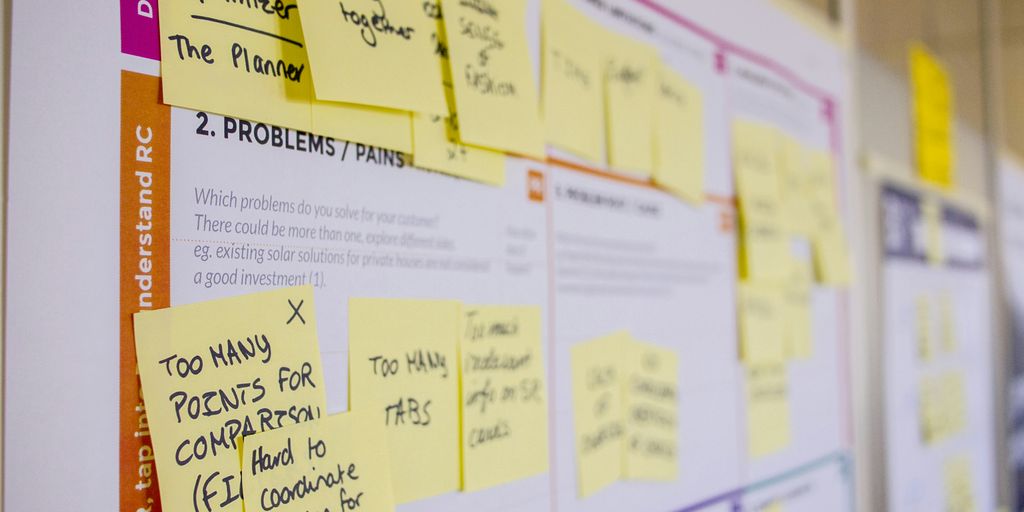News
Agile Innovation: Adapting to Change and Driving Growth

Agile innovation is a modern approach that helps companies stay flexible and responsive in a fast-changing world. By focusing on collaboration, quick adjustments, and customer feedback, businesses can create better products and services. This article explores the key aspects of agile innovation, its benefits, and how to successfully implement it in your organisation.
Key Takeaways
- Agile innovation helps companies quickly adapt to changes in the market.
- Collaboration across teams leads to more creative solutions.
- Customer feedback is essential for developing successful products.
- Agile methods like Scrum and Kanban improve efficiency.
- Organisations that embrace agility can achieve faster growth.
Understanding Agile Innovation
Defining Agile Innovation
Agile innovation is a way of developing new ideas and products that focuses on being flexible and quick. It allows teams to change their plans based on feedback and new information. This approach helps businesses stay relevant in a fast-changing world.
Key Principles of Agile Innovation
Agile innovation is built on several important ideas:
- Iterative Development: Work is done in small steps, called sprints, which helps teams test and improve their ideas quickly.
- Customer-Centric Approach: Regular feedback from customers ensures that the final product meets their needs.
- Flexibility and Adaptability: Teams are encouraged to adjust their plans based on market changes or new insights.
The Agile Manifesto and Its Evolution
The Agile Manifesto was created to guide teams in using agile methods. It focuses on:
- Individuals and interactions over processes and tools.
- Working software over comprehensive documentation.
- Customer collaboration over contract negotiation.
- Responding to change over following a plan.
Agile innovation is not just about speed; it’s about creating value through collaboration and adaptability.
In summary, understanding agile innovation is crucial for businesses aiming to thrive in today’s competitive landscape. By embracing its principles, companies can foster a culture of continuous improvement and responsiveness to change.
The Importance of Agile Innovation in Today’s Market
Market Dynamics and Agility
In today’s fast-paced world, businesses must be able to adapt quickly to changing market conditions. Agility is essential for survival. Companies that can pivot swiftly are more likely to thrive. Here are some key points:
- Rapid changes in technology and consumer preferences.
- Increased competition from agile startups.
- The need for continuous improvement to stay relevant.
Competitive Advantage Through Agility
Agile innovation provides a significant edge over competitors. Companies that embrace agility can:
- Respond faster to customer feedback.
- Launch products more quickly.
- Adjust strategies based on real-time data.
This adaptability can lead to higher profits and market share.
Case Studies of Agile Success
Several companies have successfully implemented agile innovation:
- Tesla: Rapidly develops and releases new features based on customer input.
- Amazon: Uses data analytics to adapt its offerings and improve customer experience.
- ING Bank: Transformed its operations to be more customer-centric and responsive.
These examples show how agility can drive growth and success in various industries.
In a world where change is the only constant, agility is not just an option; it’s a necessity for businesses aiming to succeed.
Implementing Agile Innovation in Your Organisation
Preparation and Planning
To successfully implement agile innovation, careful planning is essential. Here are some key steps to consider:
- Set Clear Goals: Define what you want to achieve with agile innovation. Clear targets will help guide your efforts.
- Build a Cross-Functional Team: Assemble a team with diverse skills. This variety fosters creativity and helps tackle challenges from different angles.
- Create a Roadmap: Outline the steps and milestones needed to reach your goals. This roadmap will serve as a strategic guide for your team.
Building Cross-Functional Teams
Cross-functional teams are vital for agile innovation. They should include members from various departments to ensure a mix of perspectives. Here’s how to build effective teams:
- Encourage Collaboration: Foster an environment where team members feel comfortable sharing ideas.
- Align with Agile Principles: Ensure everyone understands and embraces agile values.
- Regular Check-Ins: Hold frequent meetings to discuss progress and address any issues.
Adopting Agile Methodologies
Implementing agile methodologies can significantly enhance your innovation process. Here are three popular approaches:
- Scrum: Break projects into small, manageable sprints, typically lasting two to four weeks. Daily stand-up meetings help keep everyone on track.
- Kanban: Visualise your workflow using a Kanban board. This method helps identify bottlenecks and improve efficiency.
- Lean Startup: Focus on creating a minimum viable product (MVP) and iterating based on user feedback. This approach reduces waste and maximises value.
Agile innovation is not just about doing more in less time; it’s about working smarter and creating more value with less effort.
Conclusion
Implementing agile innovation requires a thoughtful approach, but the benefits can be substantial. By preparing effectively, building the right teams, and adopting suitable methodologies, your organisation can thrive in a rapidly changing environment. Agility is key to staying competitive.
Agile Methodologies for Innovation
Scrum Framework
Scrum is a widely used agile framework that breaks projects into small, manageable parts called sprints. Each sprint typically lasts between two to four weeks. During this time, teams hold daily stand-up meetings to discuss progress and tackle any challenges. At the end of each sprint, a review meeting is conducted to showcase completed work and gather feedback. This iterative approach allows teams to adapt quickly to changes.
Kanban Method
The Kanban method focuses on visualising the workflow. Tasks are represented as cards on a Kanban board, moving through stages like “To Do,” “In Progress,” and “Done.” This visual representation helps teams identify bottlenecks and improve efficiency.
Lean Startup Approach
The Lean Startup approach emphasises creating a minimum viable product (MVP) and iterating based on user feedback. This method reduces waste and ensures that resources are used effectively, focusing on features that truly add value to customers.
Agile methodologies encourage teams to embrace change and continuously improve their processes.
| Methodology | Key Features | Benefits |
|---|---|---|
| Scrum | Short sprints, daily stand-ups, review meetings | Quick adaptation, regular feedback |
| Kanban | Visual workflow, task management | Improved efficiency, clear progress |
| Lean Startup | MVP creation, user feedback | Reduced waste, focused development |
By adopting these agile methodologies, organisations can foster a culture of innovation and responsiveness, ultimately driving growth and success in a rapidly changing market.
Summary
In summary, agile methodologies like Scrum, Kanban, and Lean Startup provide frameworks that help teams innovate effectively. They promote collaboration, flexibility, and a focus on customer needs, making them essential for any organisation aiming to thrive in today’s dynamic environment.
Conclusion
Implementing these methodologies can lead to significant improvements in how teams approach innovation, ensuring that they remain competitive and relevant in their industries.
Benefits of Agile Innovation
Agile innovation brings several key advantages that can greatly enhance a company’s ability to thrive in a competitive landscape. Here are some of the most significant benefits:
Increased Speed to Market
Agile innovation focuses on rapid development and iteration. This means teams can quickly launch new products and services, giving them a competitive edge. Instead of waiting for a project to be fully finished, agile methods promote delivering small improvements regularly. This allows companies to start seeing value from their innovations sooner while continuously refining their offerings based on real-world feedback.
Enhanced Collaboration
Agile innovation encourages teamwork across various departments. By combining different skills and viewpoints, teams can create more effective solutions. Regular communication, such as daily meetings and reviews, helps everyone stay aligned and work towards shared goals. This collaborative spirit fosters a culture of knowledge sharing and problem-solving.
Higher Customer Satisfaction
Involving customers throughout the development process is a core principle of agile innovation. By regularly seeking feedback, teams can better understand customer needs and preferences. This customer-focused approach ensures that the final product meets expectations, leading to greater satisfaction. The iterative process of refining products based on user input increases the chances of success in the market.
Agile innovation is not just about speed; it’s about creating value through collaboration and customer engagement.
| Benefit | Description |
|---|---|
| Increased Speed to Market | Rapid development allows quicker launches and feedback integration. |
| Enhanced Collaboration | Diverse teams work together, sharing knowledge and solving problems. |
| Higher Customer Satisfaction | Regular feedback ensures products meet user needs and expectations. |
Challenges and Solutions in Agile Innovation
Common Obstacles
Agile innovation can face several challenges that may hinder its effectiveness in organisations. Some of the most common obstacles include:
- Resistance to Change: Many employees may be accustomed to traditional methods and may resist adopting new practises.
- Inefficient Leadership: Leadership that does not fully support agile principles can create confusion and misalignment.
- Lack of Training: Without proper training, teams may struggle to implement agile methodologies effectively.
Overcoming Resistance to Change
To tackle resistance, organisations can:
- Communicate Clearly: Explain the benefits of agile innovation to all team members.
- Involve Employees: Engage staff in the transition process to foster ownership and commitment.
- Provide Support: Offer resources and training to help teams adapt to new practises.
Continuous Improvement Strategies
To ensure ongoing success in agile innovation, consider these strategies:
- Regular Feedback Loops: Establish mechanisms for continuous feedback from team members and customers.
- Iterative Learning: Encourage teams to learn from each sprint and apply those lessons to future projects.
- Celebrate Successes: Recognise and reward teams for their achievements to maintain motivation and morale.
Agile innovation is not just about processes; it’s about creating a culture that embraces change and values collaboration.
By addressing these challenges head-on, organisations can unlock the full potential of agile innovation and drive growth effectively.
Agile Leadership and Culture
Role of Leadership in Agile Innovation
Effective leadership is crucial for fostering an agile culture. Leaders must inspire and empower their teams rather than simply directing them. This shift from a top-down approach to a more collaborative style is essential for driving innovation. Here are some key roles leaders should adopt:
- The Architect: Builds the necessary culture and capabilities for collaboration.
- The Bridger: Connects internal teams with external insights and tools.
- The Catalyst: Accelerates co-creation across the entire ecosystem.
Fostering an Agile Culture
Creating a culture that supports agility involves several important steps:
- Encourage Creativity: Allow team members to express their ideas freely.
- Promote Empathy: Understand and value the perspectives of others.
- Support Continuous Learning: Foster an environment where learning is ongoing and encouraged.
A strong culture of innovation is vital for organisations aiming to stay competitive and responsive to change.
Training and Development for Agility
Training is essential for developing agile leaders and teams. Here are some effective strategies:
- Just-in-Time Training: Provide training modules that are accessible when needed.
- Collaborative Platforms: Use tools that facilitate real-time communication and feedback.
- Gamification Techniques: Implement recognition systems that reward agile practises.
By focusing on these areas, organisations can cultivate a robust agile culture that drives innovation and growth.
Tools and Software for Agile Innovation
In the world of agile innovation, having the right tools is crucial for success. Innovation management software plays a key role in coordinating efforts, improving teamwork, and keeping track of progress in innovation projects.
Innovation Management Software Features
When selecting software for agile innovation, consider these important features:
- Idea Management: Tools that help capture, organise, and prioritise ideas from different sources.
- Collaboration Tools: Features that support communication and teamwork, like discussion forums and real-time collaboration.
- Performance Analytics: Metrics and reports that give insights into how well innovation efforts are performing.
- Project Management Capabilities: Functions for planning, tracking, and managing projects, including sprint planning and task assignments.
Step-by-Step Implementation Guide
To effectively implement agile innovation tools, follow these steps:
- Establish a Vision and Roadmap: Define a clear vision for your initiative and create a roadmap outlining the steps and milestones.
- Create and Prioritise a Backlog: Develop a backlog of tasks and ideas, prioritising them based on their potential impact and feasibility.
- Conduct Regular Sprints and Reviews: Implement a cycle of sprints, focusing on tasks from the backlog, and review progress at the end of each sprint.
- Gather and Act on Feedback: Actively seek feedback from customers and team members to make informed decisions and improve your innovations.
Agile innovation tools can unlock the full potential of your ideas, making it easier to adapt and thrive in a fast-changing market.
By leveraging the right tools and methodologies, organisations can enhance their innovation processes and drive growth effectively.
Future Trends in Agile Innovation
Emerging Technologies
The landscape of agile innovation is rapidly changing, driven by emerging technologies. These technologies include:
- Artificial Intelligence (AI): Enhancing decision-making and automating processes.
- Blockchain: Providing transparency and security in transactions.
- Internet of Things (IoT): Enabling real-time data collection and analysis.
Evolving Agile Practises
As organisations adapt, agile practises are also evolving. Key trends include:
- Hybrid Methodologies: Combining agile with traditional methods for better flexibility.
- Remote Collaboration Tools: Facilitating teamwork across distances.
- Data-Driven Decision Making: Using analytics to guide innovation strategies.
Predictions for the Future
Looking ahead, we can expect:
- Increased Focus on Sustainability: Innovations that prioritise environmental impact.
- Greater Personalisation: Tailoring products and services to individual customer needs.
- Enhanced Customer Engagement: Involving customers more deeply in the innovation process.
The future of agile innovation is not just about speed; it’s about creating value through continuous adaptability and responsiveness to market needs.
In summary, the future of agile innovation will be shaped by technology, evolving practises, and a strong focus on customer engagement and sustainability. Companies that embrace these trends will be better positioned to thrive in a competitive landscape.
Case Studies of Agile Innovation
Tesla and SpaceX
Both Tesla and SpaceX exemplify agile innovation by rapidly adapting to changes and pushing boundaries. They have developed a unique approach that goes beyond traditional agile methods, allowing them to innovate at an impressive pace. Their focus on cross-functional collaboration and customer feedback has led to groundbreaking advancements in technology and product development.
Amazon
Amazon is another prime example of agile innovation. The company continuously evolves its services based on customer needs and market trends. By employing agile methodologies, Amazon can quickly launch new products and features, ensuring they remain competitive. Their use of data analytics to inform decisions is a key factor in their success.
ING Bank
ING Bank has embraced agile practises to enhance its operations and customer service. By restructuring teams into smaller, agile units, they have improved their responsiveness to market changes. This shift has resulted in faster decision-making and a more customer-centric approach, ultimately leading to higher satisfaction levels.
| Company | Agile Approach | Key Outcomes |
|---|---|---|
| Tesla | Cross-functional teams | Rapid product development |
| SpaceX | Iterative testing and feedback | Innovative space technology |
| Amazon | Data-driven decision making | Continuous product improvement |
| ING Bank | Small agile units | Enhanced customer service |
Agile innovation is not just about speed; it’s about creating a culture that embraces change and encourages experimentation.
By studying these companies, we can see how agile innovation can lead to significant growth and success in various industries.
Measuring the Success of Agile Innovation

Key Performance Indicators
To effectively measure the success of agile innovation, it’s essential to track specific key performance indicators (KPIs). These metrics help assess how well your agile initiatives are performing. Here are some important KPIs to consider:
- Time to Market: How quickly can you deliver new products or features?
- Customer Satisfaction: Are your customers happy with the innovations?
- Team Velocity: How much work is your team completing in each sprint?
Feedback Loops
Regular feedback is crucial in agile innovation. Establishing effective feedback loops allows teams to:
- Gather insights from customers and stakeholders.
- Make necessary adjustments to products or processes.
- Enhance overall project outcomes based on real-time data.
Continuous Assessment
Continuous assessment is vital for ensuring that agile practises are effective. This involves:
- Regularly reviewing project goals and outcomes.
- Adjusting strategies based on performance data.
- Encouraging a culture of continuous improvement within teams.
Agile innovation is not just about speed; it’s about creating value and adapting to change.
By focusing on these areas, organisations can better understand the impact of their agile efforts and make informed decisions to drive future innovations. Remember, measuring success is an ongoing process that requires commitment and adaptability.
Conclusion
In summary, agile innovation is essential for businesses aiming to thrive in today’s fast-paced world. By embracing flexibility and quick responses to change, companies can not only keep up but also lead in their industries. This approach encourages teamwork and values customer feedback, ensuring that products meet real needs. As we move forward, those who adopt agile methods will find themselves better equipped to face challenges and seize opportunities. Ultimately, agility isn’t just a strategy; it’s a mindset that can drive lasting success.
Frequently Asked Questions
What is agile innovation?
Agile innovation is a way of developing new ideas quickly and flexibly. It helps teams adapt to changes and improve their products based on feedback.
Why is agile innovation important?
Agile innovation is important because it allows companies to respond quickly to market changes and customer needs, helping them stay competitive.
What are some key principles of agile innovation?
Key principles include working in short cycles, focusing on customer feedback, and being flexible to changes.
How can my organisation implement agile innovation?
To implement agile innovation, start by setting clear goals, forming diverse teams, and using agile methods like Scrum or Kanban.
What are some benefits of agile innovation?
Benefits include faster product launches, better teamwork, and higher customer satisfaction.
What challenges might we face with agile innovation?
Challenges can include resistance to change, lack of understanding, and difficulties in collaboration.
How can leadership support agile innovation?
Leadership can support agile innovation by promoting an open culture, encouraging teamwork, and providing training.
What tools can help with agile innovation?
Tools like project management software and collaboration apps can help teams work together more effectively.
-

 Press Release6 days ago
Press Release6 days agoBellarium ($BEL) Price Prediction: Could It Hit $5 by 2026?
-

 Press Release3 days ago
Press Release3 days agoClinical Trials Market Set for Robust Growth, Driven by Drug Development Surge and Digital Innovation
-

 Business5 days ago
Business5 days agoHow Managed IT Solutions Help Small Teams Compete at Enterprise Scale
-

 Press Release4 days ago
Press Release4 days agoPreventive Vaccines Market to Witness Strong Growth by 2035
-

 Press Release4 days ago
Press Release4 days agoIndustrial Boiler Market Expected to Surpass USD 24.4 Billion by 2035 Amid Growing Demand for Energy Efficiency and Industrialization
-

 Press Release4 days ago
Press Release4 days agoGreen Bio Chemicals Market Poised for Sustainable Growth amidst Global Shift to Eco-Friendly Alternatives by 2035
-

 Press Release4 days ago
Press Release4 days agoFill-Finish Pharmaceutical Contract Manufacturing Market Expected to Flourish Amid Biopharmaceutical Boom and Global Outsourcing Trend by 2035
-

 Press Release4 days ago
Press Release4 days agoPet Food Nutraceutical Market Set for Robust Expansion Amid Rising Demand for Pet Wellness by 2035
























